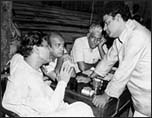Shombu Mitra, colossus of Indian theatre, dead
 Shombu Mitra is dead.
Shombu Mitra is dead.
Widely considered to be the greatest exponent of modern Indian theatre, Mitra died on Monday morning at his Calcutta home after a long illness. He was 82 and is survived by his daughter Saoli Mitra, a wellknown stage personality. His wife actress Tripti Mitra died in 1989.
According to his last wishes ratified in a court paper, without fanfare or intimation to the media, Mitra was cremated at 5.35 am in a south Calcutta cemetery, a few hours after his death at 2.15 am.
Drawing his inspiration both from Occidental and Oriental literature, Mitra, who championed the theatre movement in India since the forties, produced plays like Raja Oedipus, Galileo, Putul Khela (adaptation of Henryk Ibsen's A Doll's House), Dashachakra, Rabindranath Tagore's Raktakarabi, Char Adhayay, Bisharjan (Immersion) and Raja and went on to win accolades that made him an icon of Indian theatre.
One of the leading lights of the Indian Peoples Theatre Association, he started his career with Nabanna, a comment on the Bengal famine. He later went on to found the Bahurupee theatre group in 1948. Mitra also dabbled with considerable success in films, directing the national award winner Jagte Raho (Ekdin Raatre in Bengali) for RK Studios, casting Raj Kapoor in a stellar role.
Mitra was awarded the Magsaysay award in 1979, the year in which he quit Bahurupee. He had already bagged the Padma Bhushan in 1970, the Kalidas Samman and Visva Bharati's Deshikotaam awards in 1983.
After leaving Bahurupee, Mitra acted in Mudra Rakshas under the direction of Rudraprasad Sengupta of the Nandikar group. He also staged Galileo for the Calcutta Repertoire Theatre. In 1994, he read out the new play he had written, Chandra Banikar Pala. However, he could not stage the play as there was no theatre large enough in Calcutta.
Shombu Mitra also hoped to set up a national theatre complex. However, this remained an unrealised dream because he never succeeded in getting land from the West Bengal or central governments. The funds he raised for this purpose were later donated to a cancer hospital.
He lived an austere life and, his last wishes recorded in a court paper, ensured that his body be neither kept at Rabindra Sadan -- the tradition for doyens of the Bengal art world -- for public homage nor taken to the crematorium winding through the thoroughfares in procession.
For a man who symbolised drama in Indian culture, Mitra's exit from the stage of life was curiously undramatic, silent and peaceful.
Amol Palekar remembers Shombu Mitra
|





